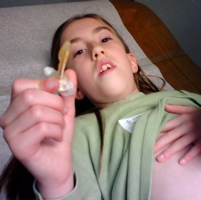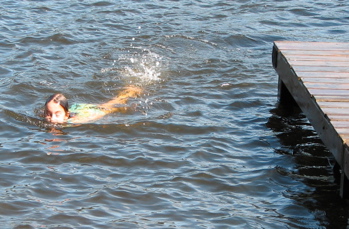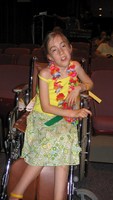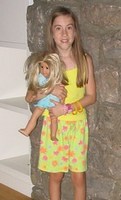Here's what's new with Ruth:
November 15, 2006
No more G-tube.
Today, we removed Ruth's gastro-intestinal tube (a.k.a. her button, the mic-key).

Ruth is now a fully independent unit! She was ready to remove it
last September, and to be fair, hasn't needed it since then. However, we wanted to see her make it through a whole winter without needing and then we
wanted to avoid a surgical procedure and... and... ok, we were scared. There, I said it.
It turns out we needn't have worried, the stoma closed up in 2 days -- without a suture. Ruth is so pleased with her flat stomach, she has never known a time when she didn't have a g-tube, so this is a whole new world for her. Very nice.
June 18, 2006
Ruth can swim. Unbelievable. She is doing some kind of modified breaststroke, but she swam the width of the shallow end of our local pool today, we
are going up to Lake Huron for Canada in early July, she's ready for a real lake.

late March, 2006
Ruth is now an excellent student, she went from Good to Excellent overall this quarter. Her stamina has improved and her reading/writing skills much more substantial. We are working on Math, which she still struggles with a bit, especially the writing of so many equations, etc.
late October, 2005
Ruth is now a fairly good student, she went from Satisfactory to Good overall this quarter. It is amazing how much the diagnosis (below) and the medicine have helped her everday ability.
August 6, 2005
At last. A final diagnosis for Ruth.
We returned August 6, 2005 from the Mayo Clinic in Rochester, MN after a week of testing and fantastic results from their Pediatric Neurology department.
Ruth has a neuromuscular disease called Congenital Myasthenic Syndrome [CMS].
Congenital Myasthenia affects the function of processes at the junction of nerve and muscle cells. Patients with this disease are often mis-diagnosed and usually not diagnosed correctly until several years pass.
On Monday August 1, 2005 we consulted with the Mayo Clinic's pediatric neurologist Dr. Nancy Kuntz. Together with Dr. Kuntz we reviewed the results of Ruth's muscle biopsies (1995 and 2001), along with some of Ruth's previous blood work. Dr. Kuntz was able to rule out muscle tissue deformity, metabolic disorders and many muscular dystrophies. In particular, the lab work from Columbia-Presbyterian was very thorough. Dr. Kuntz recommended we test Ruth's nerve/muscle junction.
Layman's terms: If Ruth were a car, a mechanic would say the carburetor is working, she has plenty of gas but she we're not getting a spark. He'd check her electrical system.
Dr. Kuntz recommended an electromyograph [EMG] to test the way Ruth's nervous system interacts with her muscles. Passing waves of electricity through Ruth's skin and muscle, the surgeons stimulated Ruth's muscles to verify that her nervous system is not efficiently connected to her muscle tissue -- Ruth has a myasthenic syndrome.
Mestinon is prescribed to myasthenic patients to improve the way the nerve/muscle junction, works. "Mestinon prevents the breakdown of acetylcholine (pronounced "a cee til coline") by allowing more acetylcholine to accumulate. Acetylcholine is the chemical that sends nerve impulses to the muscle. With more acetylcholine, there is more control of voluntary functions such as eye movements, limited strength, swallowing and breathing." Source: http://www.mestinon.com
On Mestinon, Ruth's muscles are contracting much more than they were, for much longer periods. We still have a long way to go and a lot to learn, but this opens a whole new future for Ruth.


Here's a list of the things Ruth can do since she started taking Mestinon on Thursday, August 4, 2005:
Day 1
- Smile
- Eat all of her lunch
- Walk 2 city blocks
- Jump into a pool without assistance
Day 2
- Walk gracefully (no toe in, no foot drop)
- Braid her hair
- Tolerate a 10 hour trip by car
- Eat all of her HUGE lunch
Day 3
- Stay up until 11 pm
- Tolerate a 12 hour trip by car
- Raise her eyebrows
Day 4
- Stand in the ocean by herself
- Walk on sand by herself
Pretty amazing, eh?
For additional information about Congenital Myasthenia visit these links:
National
Institutes for Health -- Congenital Myasthenia
Muscular Dystrophy Assocation -- Congenital Myasthenia
Washington
University’s Department of Neurology -- Congenital
Myasthenias
[NOTE: this last one is for the more medically inclined]
